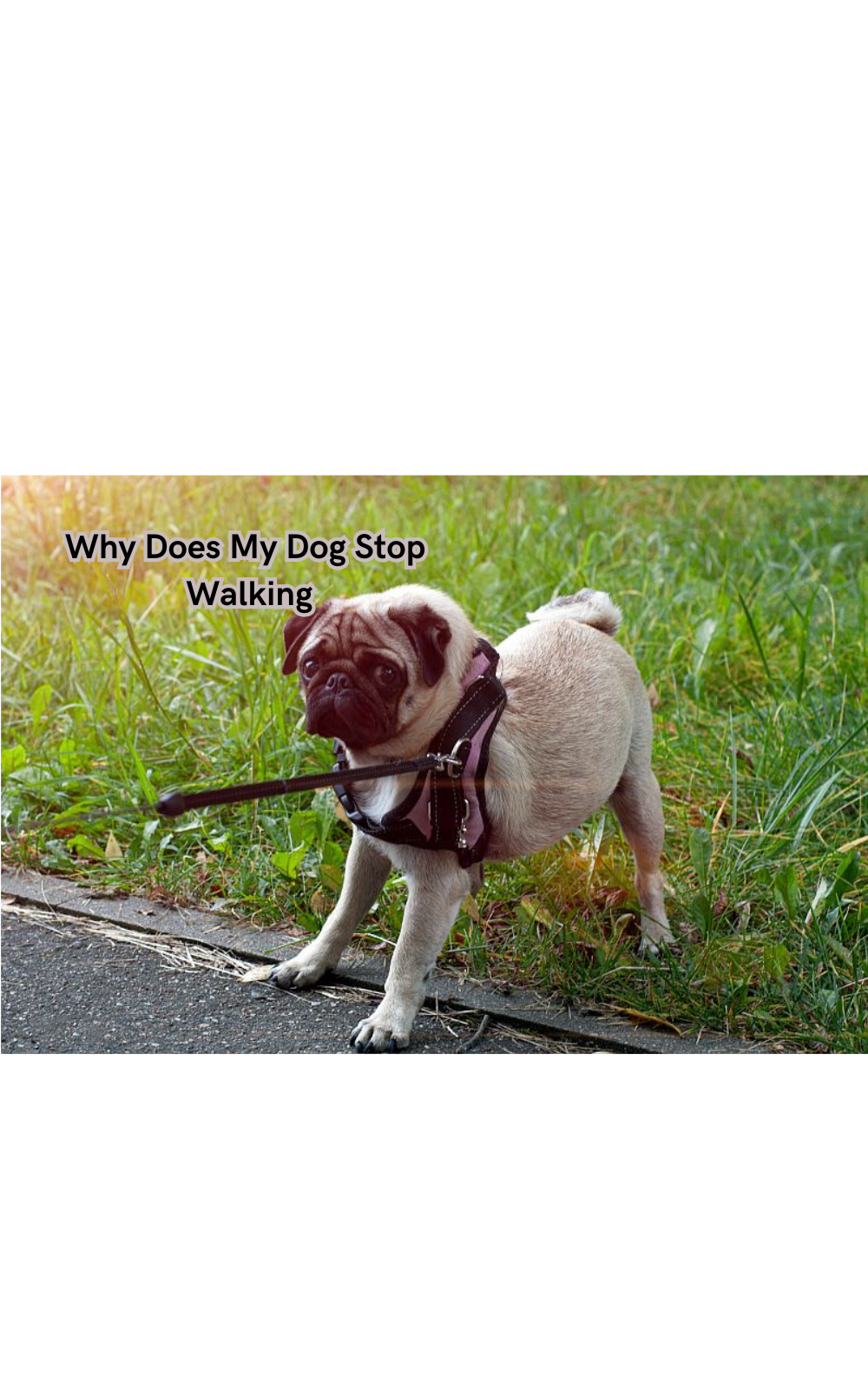Why Does My Dog Stop Walking
Various factors, including physical discomfort, fear, behavioral issues, or curiosity, could prompt your dog to halt mid-walk. Unraveling the mystery behind why your dog stops walking is essential for fostering a harmonious walking experience and addressing any underlying issues.

Witnessing your beloved canine companion suddenly stopping during a walk can be puzzling and concerning. Understanding the reasons behind this behavior is crucial for ensuring your furry friend's well-being and maintaining enjoyable walks together.
Various factors, including physical discomfort, fear, behavioral issues, or curiosity, could prompt your dog to halt mid-walk. Unraveling the mystery behind why your dog stops walking is essential for fostering a harmonious walking experience and addressing any underlying issues.
By delving into the potential causes and implementing appropriate strategies, you can cultivate a deeper bond with your pet and pave the way for more pleasant strolls in the future.
Importance of Dog Walking
Walking is not only a crucial aspect of your dog's physical and mental well-being, but it also serves as an opportunity for bonding and training. Regular walks provide essential exercise to keep your dog physically fit and healthy, preventing obesity and related health issues.
Moreover, walking allows dogs to release energy and stimulate their senses, keeping them mentally stimulated and engaged. It also aids in relieving stress and anxiety, promoting relaxation and a sense of calmness.
Additionally, walking provides an excellent platform for training and reinforcing good behavior, such as proper leash manners and socialization skills. By consistently taking your dog on walks, you can establish a routine that promotes structure and discipline.
Why Does My Dog Stop Walking: Potential Causes and Strategies
Now, we discuss reasons why your dog may suddenly stop walking and potential strategies to address them. If young puppies or elderly dogs exhibit this behavior, it could be due to fatigue or physical limitations. In such cases, allowing frequent breaks and adjusting the pace of walks can help accommodate their needs.
Physical Discomfort:
If your dog suddenly stops walking and shows signs of discomfort, such as limping or whining, it could be due to physical pain.
Dogs may experience joint pain, muscle strains, or paw injuries that can make walking uncomfortable for them. Due to these dogs stop walking and won't move, seeking veterinary care and determining the root cause of your dog's pain is crucial for alleviating their discomfort and getting them back on their paws.
In such cases, it is essential to stop the walk immediately and check your dog's paws and body for any visible injuries or signs of discomfort.
If your dog's walking gear is causing discomfort, such as a tight leash or ill-fitting collar, make the necessary adjustments for a more comfortable walking experience. Adult dogs walking and suddenly peeing may be due to bladder issues, so consulting a veterinarian is necessary.
Fear and Anxiety:
Fear and anxiety can also cause your dog to stop walking. Dogs may become scared or anxious due to various reasons, such as encountering loud noises, unfamiliar surroundings, or other dogs. In these situations, remaining calm and using positive reinforcement techniques, such as treats and verbal praise, can help alleviate your dog's fear and encourage them to resume walking.
Usual walk to dogs stop walking, and sniffing means they are trying to gather information from their surroundings, which is a natural behavior. Allow them to explore within reason and encourage them with praise and rewards.
It is essential to identify potential triggers that may cause fear or anxiety in your dog and work on desensitizing them through training and exposure in a controlled environment. Manage your dog's fear safely and efficiently.
Not Enough Leash Training:
Dogs that are not adequately trained to walk on a leash may also stop abruptly during walks, leading to frustration for both the dog and the owner.
In such cases, it is essential to invest time in proper leash training techniques and teach your dog to walk calmly by your side. If it's not trained, it can refuse to walk and sit down.
Using rewards, positive reinforcement, and consistent training can help improve your dog's leash manners and prevent them from stopping mid-walk. Additionally, practicing leash walking in familiar and quiet environments can help your dog feel more comfortable and confident before advancing to busier areas.
Curiosity:
Dogs can stop walking immediately if something catches their attention, such as a squirrel or an enticing smell. Your dog may become intently focused on the object and refuse to move until they have thoroughly explored it.
In these situations, giving your dog some time to satisfy their curiosity and then redirecting their attention back to walking can help them continue the walk without interruptions. Routes stop walking and look around means your dog is probably curious about something in their surroundings, so be patient and allow them some time to investigate.
Fatigue:
Dogs refuse to walk because they may simply be tired, especially after a full day of physical activity or in hot weather. An unfamiliar environment may also lead to fatigue, causing them to stop and rest.
In such cases, providing frequent breaks and ensuring your dog stays hydrated can help prevent exhaustion and ensure a comfortable walking experience. Constitute medical advice, provide adequate rest, and avoid strenuous activities in extreme weather conditions to keep your dog safe and healthy.
Other Possible Reasons Why Your Dog Doesn't Want To Walk
Aside from the potential reasons mentioned above, there could be other underlying causes for your dog to stop walking or show reluctance towards walks. These may include:
- Medical issues: Dogs who are in pain or have underlying health conditions may not want to walk. It is essential to consult a veterinarian if your dog's behavior persists or worsens.
- Traumatic past experiences: Dogs that have had negative experiences on walks, such as getting lost or being attacked by other dogs, may develop fear and anxiety towards walking. In these cases, professional help from a certified dog trainer can aid in behavior modification and building confidence.
- Lack of socialization: Dogs that are not adequately socialized at a young age may become fearful or aggressive towards unfamiliar people, animals, or environments on walks. Proper socialization training can help alleviate these behaviors and make walks more enjoyable for both the dog and the owner.
- Boredom: Dogs that are not mentally stimulated may show disinterest in walks as they do not provide enough mental stimulation. Providing ample playtime, interactive toys, and mental exercises can help keep your dog mentally engaged and excited for walks.
These are just a few examples of why your dog may not want to walk. It is essential to observe and understand your dog's behavior and seek professional advice if needed to ensure they have a happy and healthy walking experience.
Tips for a Successful Walk with Your Dog
Naturally, all dogs have different personalities and preferences, so what works for one may not work for another. However, here are some general tips to keep in mind for a successful and enjoyable walk with your dog:
- Start slow: If your dog is new to walking or has had negative experiences in the past, start with short walks and gradually increase the duration and distance. Enclosed dog-run areas can also be a good starting point for leash training and socialization before venturing out on walks.
- Be patient: Dogs can get easily distracted, so it is essential to remain patient and calm during walks. Allow them some time to sniff and investigate their surroundings before moving on.
- Use positive reinforcement: Rewarding your dog with treats or verbal praise when they behave well during walks can encourage good behavior and make the experience more enjoyable for them.
- Be prepared: Always bring essentials like water, poop bags, and a first-aid kit in case of any emergencies. Also, consider the weather and plan your walks accordingly to keep your dog safe and comfortable.
- Seek professional help if needed: If your dog's behavior on walks is concerning or causing disruption in their daily routine, do not hesitate to seek professional help from a veterinarian or certified dog trainer.
By understanding the possible reasons behind your dog's refusal to walk and implementing these tips, you can encourage positive behavior to avoid overwhelming or frightening experience for both you and your dog. Remember to always prioritize your dog's safety, comfort, and happiness during walks.
FAQs
Why does a dog not want to walk?
There can be various reasons why a dog may not want to walk, such as lack of leash training, curiosity towards surroundings, or fatigue. Other factors like medical issues, traumatic past experiences, and boredom can also contribute to this behavior. It is essential to observe your dog's behavior and seek professional help if needed to determine the cause.
Should I force my dog to walk?
Forcing your dog to walk can cause further stress and anxiety, leading to negative associations with walks. It is crucial to address the underlying reason for their reluctance and work on it through positive reinforcement and professional help if needed.
How do I motivate my dog to walk?
Motivating your dog to walk can be done through positive reinforcement, such as rewarding good behavior with treats or verbal praise. Starting with short walks and gradually increasing the distance can also help build their confidence and make walking more enjoyable for them.
What does dog depression look like?
Dog depression can manifest in various ways, including loss of appetite, lethargy, excessive sleeping, isolation, and withdrawal from activities they once enjoyed. It is important to consult a veterinarian if you notice any sudden changes in your dog's behavior.
Conclusion
In conclusion, deciphering why your dog stops walking is vital to nurturing a positive walking experience and ensuring your pet's well-being.
Whether from physical discomfort, anxiety, environmental factors, or behavioral issues, the pause in movement communicates valuable insights into your dog's needs. By attentively observing and understanding these cues, you can cultivate a deeper bond with your canine companion and address any underlying concerns.
Implementing gentle training techniques, seeking professional guidance when necessary, and providing a supportive environment can empower you and your dog to enjoy walks to the fullest.
Decoding the reasons behind your dog's reluctance to walk lays the foundation for fostering trust, enhancing communication, and strengthening the cherished bond between humans and canines.
